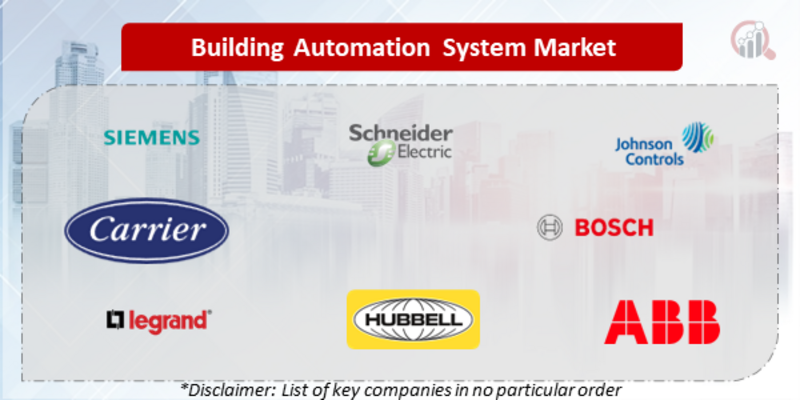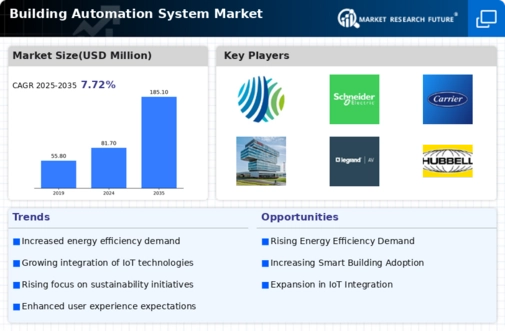Top Industry Leaders in the Building Automation System Market

Competitive Landscape of Building Automation System Market:
The building automation system market, where smart buildings hum with connected technology. From optimizing energy consumption to enhancing comfort and security, these digital maestros conduct a complex performance, ensuring efficient operations and sustainable living. In this dynamic arena, established giants and agile innovators clash, all vying for a bigger share of the building automation spotlight. Let's dissect the key strategies and players shaping this captivating scene.
Key Players:
-
Siemens AG
-
Johnson Control
-
Schneider Electric
-
Carrier
-
Robert Bosch
-
Legrand
-
Hubbell
-
ABB
-
Trane Technologies
-
Lutron Electronics
-
Creston Electronics
-
Hitachi
-
Delta Controls
-
Beckhoff Automation
-
Lennox International
-
General Electric
-
Distech Controls
-
Dialight PLC
-
Cisco Systems
-
Rockwell Automation
-
Control4
-
Signify (Philips Lighting)
-
Emerson Electric
-
Leviton Manufacturing Company
Strategies Adopted by key Players:
- Technological Differentiation: Companies compete fiercely on technological advancements, focusing on factors like improved connectivity protocols, advanced artificial intelligence for predictive maintenance and energy optimization, seamless integration with cloud-based platforms, and enhanced cybersecurity safeguards. Developing interoperable systems, optimizing data analytics for actionable insights, and integrating advanced sensors for real-time monitoring are key differentiators.
- Expanding Application Reach: Moving beyond traditional energy efficiency and comfort applications to address the needs of diverse sectors like education, healthcare, hospitality, and retail unlocks new market segments and drives wider adoption. Developing building automation solutions for specific environments, such as hospitals requiring sterile air control or schools needing automated lighting adjustments, is crucial.
- Addressing Cost and Accessibility: Making building automation systems more affordable and user-friendly is vital for widespread adoption. Offering modular and scalable solutions, simplifying user interfaces, and reducing installation and maintenance costs are key strategies.
- Building Partnerships and Collaborations: Fostering partnerships with construction companies, facility management service providers, technology providers, and research institutions accelerates innovation, shares expertise, and expands market reach. Collaborating on industry standards, developing pilot projects for smart building technologies, and promoting the benefits of building automation for sustainability and operational efficiency contribute to market growth.
Factors for Market Share Analysis:
- Revenue Generated: This straightforward metric reflects a company's market penetration and financial strength.
- Number of Building Automation Systems Installed: Understanding the volume of deployed systems provides insight into customer adoption and market reach.
- Technology Advancements: Assessing a company's investment in R&D, patent portfolio, and cutting-edge building automation technologies helps gauge its future competitive edge.
- Customer Satisfaction: Analyzing user feedback and loyalty metrics reveals how effectively a company caters to customer needs and builds brand reputation.
Latest Company Updates:
August 2023- STMicroelectronics introduced a new infrared (IR) sensor for detecting human presence and movement in building automation systems. The sensor can improve security systems, home automation devices, and IoT products that commonly use passive infrared (PIR) sensing. The new STHS34PF80 sensor is cost-effective and ultra-low power. It allows building automation to work consistently whether people are moving or stationary. The sensor is produced using an innovative mix of CMOS chip manufacturing, silicon micromachining, and low-voltage circuit design skills.
May 2023- Carrier Global Corporation CARR recently launched the latest version 8.5 of its i-Vu Pro building automation system software. This new software release aims to strengthen Carrier's Heating, Ventilation and Air Conditioning (HVAC) business segment. The updated software has new features such as an operator report for improved security, a staged process for more efficient controller updates, and MQTT integration to enable IoT connectivity. These enhancements are designed to bolster system security, simplify updates, and allow data integration for data-driven business decisions. This product is expected to help Carrier gain more commercial customers across industries who need smart climate and energy solutions for their buildings. This may in turn contribute to revenue growth for Carrier.
April 2023- 75F, the world's top Internet of Things (IoT) building management system, unveiled its new products and solutions for building automation at the recent three-day ACREX India exhibition. The event, organized by ISHRAE (Indian Society of Heating, Refrigeration and Air Conditioning Engineers), was held from March 14th to 16th at the Bombay Exhibition Centre in Mumbai. At this major industry event, 75F showcased its latest innovations in building automation systems and technology.








